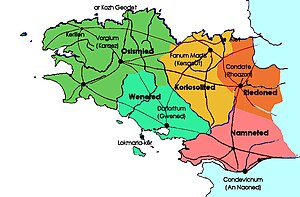Coriosolites

The Coriosolites or Curiosolitae were a
Name
They are mentioned as Coriosolitas (var. coriosolitos, curiosolitas, curiosolitas) and Coriosolites (var. coriosultes, coricoriosuelites, cariosu-) by Caesar (mid-1st c. BC),[1] and as Coriosvelites by Pliny (1st c. AD).[2][3]
The etymology of the
The city of Corseul, attested ca. 400 AD as civitas Coriosolitum ('civitas of the Curiosolites', Aecclesia Corsult ca. 869, Corsout in 1288) is named after the Gallic tribe.[6]
Geography
Territory

The Coriosolites are mentioned by Caesar together with the
Settlements
The ancient settlement of Corseul was most likely established ex nihilo by the Roman authorities during the reign of Augustus, as the capital of the civitas Coriosolitum.[9] The town is generally identified with the settlement of Fanum Martis ('temple of Mars') mentioned on the Tabula Peutingeriana (5th c. AD). Due to the lack of early epigraphic record, however, the original Gaulish name of the town remains unknown.[10] Corseul reached at size of 47ha in the first centuries of the Common Era.[11]
Around 340 AD, the capital of the civitas was moved to
Notes
- ^ Caesar. Commentarii de Bello Gallico, 2:34, 3:7:4, 7:75:4.
- ^ a b Pliny. Naturalis Historia, 4:18.
- ^ a b Falileyev 2010, s.v. Coriosolites.
- ^ Delamarre 2003, p. 125.
- ^ Lambert 2008, pp. 96–97.
- ^ Nègre 1990, p. 153.
- ^ Caesar, B. G. ii. 34.
- ^ Caesar, B. G. vii. 75.
- ^ Kerébel 2004, pp. 412–413.
- ^ a b Kerébel 2004, p. 411.
- ^ Kerébel 2004, p. 414.
Bibliography
- ISBN 9782877723695.
- Falileyev, Alexander (2010). Dictionary of Continental Celtic Place-names: A Celtic Companion to the Barrington Atlas of the Greek and Roman World. CMCS. ISBN 978-0955718236.
- Kerébel, Hervé (2004). "Corseul / Fanum Martis (Côtes-d' Armor)". Supplément à la Revue archéologique du centre de la France. 25 (1): 411–415.
- .
- ISBN 978-2-600-02883-7.

